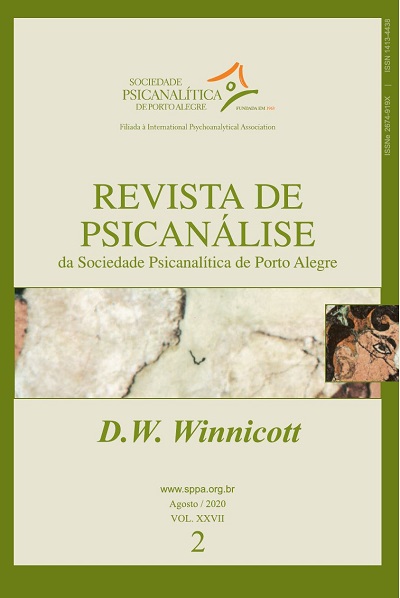O encontro entre o sujeito e o objeto não-Eu
Palavras-chave:
Sujeito, Objeto não-Eu, Subjetivação, Fenômenos transicionais, Agressividade, IntegridadeResumo
A autora propõe uma reflexão sobre a complexa articulação do pensamento winnicottiano a respeito das relações objetais. Em seu texto sobre o uso do objeto, Winnicott destaca o uso da pulsão destrutiva para conferir caráter de alteridade ao objeto e independência ao sujeito, com base no contato com seu núcleo pulsional. Na teorização do objeto transicional, Winnicott destaca o caráter perceptivo e sensorial dessa relação, que se abre para o encontro com o objeto não-Eu, sem o risco de aniquilação da vida psíquica do sujeito, responsável por ampliar e enriquecer o seu recipiente mental e os seus processos de identificação. Para lidar com essa contradição em relação à presença do objeto na vida mental do sujeito, o conceito de integridade dos objetos de Bollas mostra-se útil. As experiências emocionais estão relacionadas aos objetos que as acionam. De acordo com Bollas, construímos o nosso idioma através da inteligência das formas, configurando nossa vida através da escolha de objetos que têm uma completude. A integridade de um objeto tem a estrutura potencial capaz de iniciar processos associativos e elaborativos (AU)Downloads
Referências
Anzieu, D. (1985). Le Moi-Peau. Paris: Dunod.
Balint, M. (1968). The basic fault: therapeutic aspects of regression. London: Taylor and Francis.
Bollas, C. (1992). The shadow of the object. London: Routledge.
Bollas, C. (1995). Cracking up. Lonson: Routledge.
Bollas, C. (2009). The evocative object world. London: Routledge.
Bollas, C. (2013). China on the mind. London: Routledge.
Ferro, A. (2002). Fattori di malattia, fattori di guarigione. Milano: Raffaello Cortina. (Seeds of illness, seeds of recovery. London: Routledge, 2004).
Ferruta, A. (2003). La terza area- resting place of illusion. Psiche, 2, 31-41.
Ferruta, A. (2017). Object presence and absence in Psychic development, 1964-1966. “My latest brain-child”. In A. T. Kabesh (Ed.), Twelve essays on Winnicott: theoretical developments and clinical innovations (pp. 129-145). New York: Oxford University Press; The Winnicott Trust, 2019.
Green, A. (2005). Jouer avec Winnicott. Paris: Puf.
Winnicott, D.W. (1958a). Transitional objects and transitional phenomena. In Collected papers: through paediatrics to psycho-analysis. London: Tavistock. (Original work published in 1951)
Winnicott, D.W. (1958b). Metapsychological and clinical aspects of regression within the psycho-analytical set-up. In Collected papers: through paediatrics to psycho-analysis. London: Tavistock. (Original work published in 1954)
Winnicott, D.W. (1975a). Playing and reality. London: Tavistock. (Original work published in 1971)
Winnicott, D.W. (1975b). The use of an object and relating through identifications. In Playing and reality (pp. 86-94). London: Tavistock. (Original work published in 1971[1951])
Winnicott, D.W. (1984). Communicating and not communicating leading to a study of certain opposites. In The maturational processes and the facilitating environment: studies in the theory of emotional development. London: Hogarth Press. (Original work published in 1963)
Winnicott, D.W. (1987). The spontaneous gesture: selected letters of D.W. Winnicott (Edited by F.R. Rodman). London: The Winnicott Trust.
Winnicott, D.W. (1988). Human nature. Eds. C. Bollas, M. Davis & R. Shepherd. London: Free Association, 1990.
Winnicott, D.W. (1989). Fear of breakdown. In C. Winnicott, R. Shepherd, M. Davis (Eds.), In Psycho-analytic explorations: D.W. Winnicott. Cambridge, MA: Harvard University Press. (Original work published in 1963)
Winnicott, D.W. (1989). The psychology of madness: a contribution from psycho-analysis. In C. Winnicott, R. Shepherd, & M. Davis (Eds.), Psycho-analytic explorations: D.W. Winnicott. Cambridge, MA: Harvard University Press. (Original work published in 1965[1963])
Winnicott, D.W. (2017a). Review: memories, dreams, reflections by C.G. Jung. In L. Caldwell, & H. Taylor Robinson (Eds.), The collected works of D.W. Winnicott. New York: Oxford University Press. (Original work published in 1964)
Winnicott, D.W. (2017b). This feminism. Draft of a talk given to the progressive league. In L. Caldwell & H. Taylor Robinson (Eds.), The collected works of D.W. Winnicott. New York: Oxford University Press. (Original work published in 1964)
Winnicott, D.W. (2017c). Roots of aggression. In L. Caldwell, & H. Taylor Robinson (Eds.), The collected works of D.W. Winnicott. New York: Oxford University Press. (Original work published in 1964)
Winnicott, D.W. (2017d). The unconscious. In L. Caldwell, & H. Taylor Robinson (Eds.), The collected works of D.W. Winnicott. New York: Oxford University Press. (Original work published in 1966)
Downloads
Publicado
Como Citar
Edição
Seção
Licença
Atribuo os direitos autorais que pertencem a mim, sobre o presente trabalho, à SPPA, que poderá utilizá-lo e publicá-lo pelos meios que julgar apropriados, inclusive na Internet ou em qualquer outro processamento de computador.
I attribute the copyrights that belong to me, on this work, to SPPA, which may use and publish it by the means it deems appropriate, including on the Internet or in any other computer processing.
Atribuyo los derechos de autor que me pertenecen, sobre este trabajo, a SPPA, que podrá utilizarlo y publicarlo por los medios que considere oportunos, incluso en Internet o en cualquier otro tratamiento informático.










